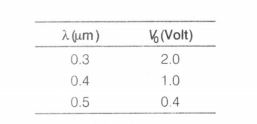In a historical experiment to determine Planck's constant, a metal surface was irradiated with light of different wavelengths. The emitted photoelectron energies were measured by applying a stopping potential. The relevant data for the wavelength λ ) of incident light and the corresponding stopping potential V0 are given below.

Given that c= 3x 108 ms-1 and e = 1.6x1019 C, Planck's constant found from such an experiment is